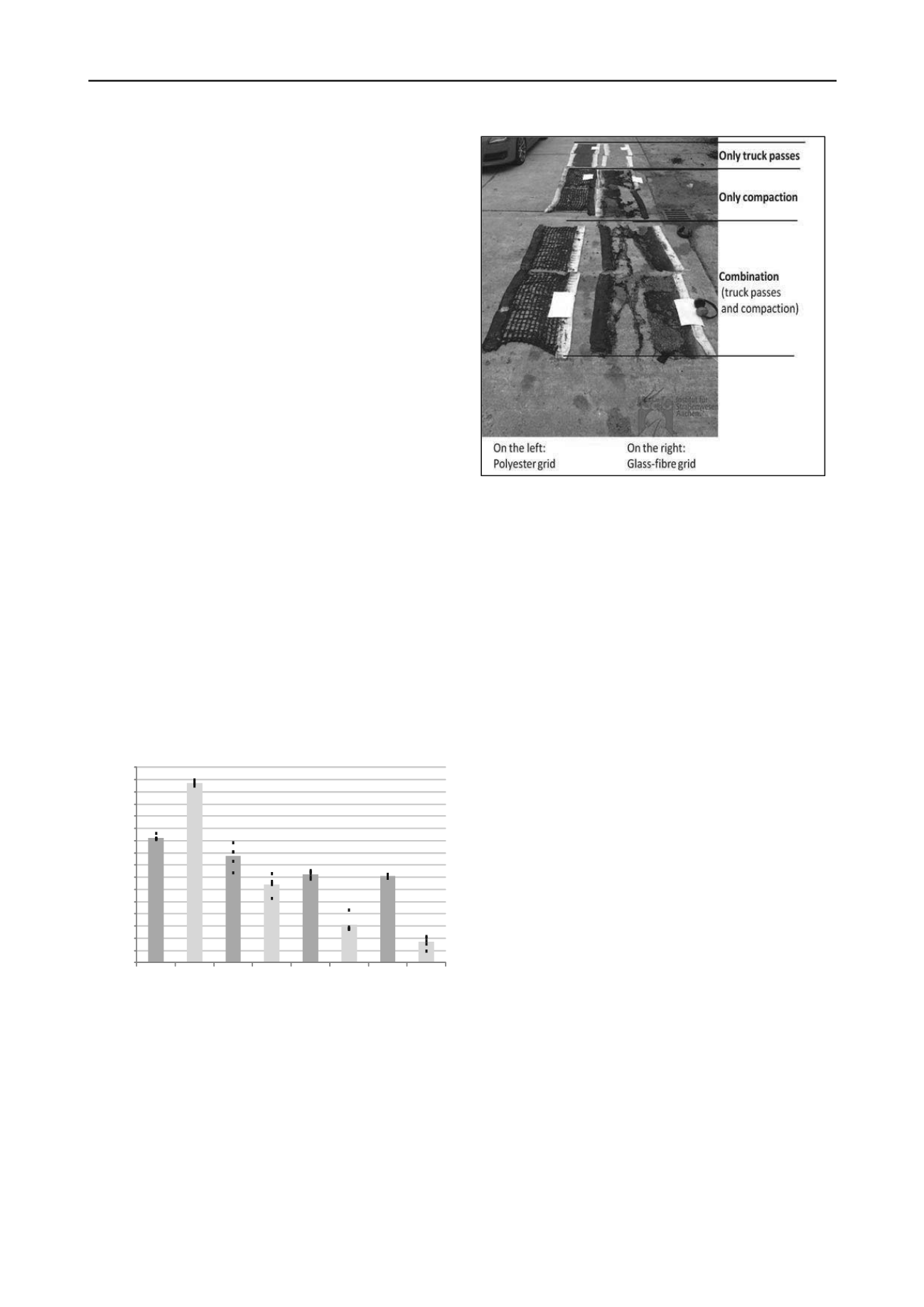
1351
Technical Committee 202 /
Comité technique 202
2.2. Results
In the context of the research the final material
characteristics (e.g. tensile strength) have been tested with the
wide width tensile test according to EN ISO 10319. To compare
the separate types of tests (variants) the property “residual
strength” was chosen. The residual strength is defined as the
maximum tensile strength after the installation damage tests,
expressed as a percentage of the maximum tensile strength of
the undamaged reference material. The detailed result can be
found in chart 1.
After the load influence “truck passes” only, the polyester grid
showed a residual strength of 85%, while the fiberglass grid had
only 44% residual strength. After the load influence
“compaction” only, the polyester grid showed a residual
strength of 71%, while the fiberglass grid had only 21%.
The polyester grid specimens which were subjected to both
loading influences - asphalt compaction and truck passes still
had a residual strength of 70% while the fiberglass grid
subjected to both loading influences revealed further damage
with a residual strength of only 11%.
The results revealed the considerable difference between the
influence from truck traffic and asphalt compaction on the
tensile strength of the specimens.
Figure 5: Results of installation damage test
3 CONCLUSIONS
2.3. Summary
After a series of testing, it can be safely concluded that
installation damage plays an important role on the “effective
tensile strength” of asphalt reinforcement products. It was found
that the polyester grid lost max. 30% of its tensile strength after
loading from truck passes and asphalt compaction. In contrast to
the performance of the polyester grid, the fiberglass grid
showed a loss of strength up to approximately 90%. The
fiberglass grid was damaged significantly more than the
polyester grid reinforcement (Figure 5).
As previously mentioned, asphalt reinforcement products must
resist as much damage as possible from the stresses and strains
applied during installation and compaction of the asphalt. Very
high forces can also be applied to the individual strands of the
reinforcement by aggregate movement within the hot asphalt
during compaction.
In the research at the RWTH Aachen University, it was
shown, that products with a brittle raw material (like fiberglass)
can lose a significant part of their tensile strength when loaded
by asphalt delivery trucks and after the asphalt compaction
(Figure 5). The results of the research are validated by results of
tests performed according to EN ISO 10722-1 “Geosynthetics:
Procedure for simulating damage during installation” (tBU
2003). Furthermore, it is expected that for fiberglass grids the
results would be worse on a milled surface.
Chart 1: Results of the wide width tensile test before and after
installation damage tests
0
5
10
15
20
25
30
35
40
45
50
55
60
65
70
75
80
0‐P
0‐G
a
b
c
d
e
f
The tests reveal that polyester grids exhibit a very good
resistance to installation damage compared to other products
made with more brittle raw materials.
Tensile Strength [kN/m]
4 REFERENCES
[1] Sakou L., 2011,
Überprüfung der Wirksamkeit von
Asphaltbewehrungssystemen
unter
Berücksichtigung
der
Einbaubedingungen,
Diploma Thesis, RWTH Aachen, Institute of
Road and Traffic Engineering, unpublished
.
[2] Institut für textile Bau- und Umwelttechnik GmbH (tBU),
Test
Report Nr. 1.1/17810/493-2003e and 1.1/17810/494-2003e, Test
method: Procedure for simulating damage during installation (acc.
to ISO EN DIN 10722-1)
[3] FGSV- AP Nr.69,
FGSV-Arbeitspapier Nr.69: "Verwendung von
Vliesstoffen, Gittern und Verbundstoffen im Asphaltstraßenbau",
Arbeitsausschuss:
Asphaltbauweisen,
Ad-hoc-Gruppe
-
Asphalteinlage, Köln, Ausgabe 2006
Type of installation damage
[4] FGSV, 2005,
Merkblatt über die Anwendung von Geokunststoffen
im Erdbau des Straßenbaus (M Geok E)
O-P: Polyester grid - undamaged reference
O-G: Glass-fibre grid - undamaged reference
[5] DIN EN ISO 10319
,
Geokunststoffe Zugversuch am breiten
Streifen (ISO 10319:2008), Oktober 2008
a: Polyester grid - Only truck passes
b: Glass-fiber grid- Only truck passes
c: Polyester grid - Only compaction
d: Glass-fibre grid- Only compaction
e: Polyester grid- Combination (truck passes and
compaction)
[6] DIN EN ISO 10722-1,
Geotextilien und geotextilverwandte
Produkte - Verfahren zur Simulation von beim Einbau auftretenden
Beschädigungen, August 2004
f: Glass-fibre grid- Combination (truck passes and
compaction)
[7] Schmalz 2005, Schmalz M.: Vorstellung des FGSV
Arbeitspapiers Nr.69 - Verwendung von Vliesstoffen,
Gittern und Verbundstoffen im Asphaltstraßenbau, Asphalt-
und Straßenbau. Seminar 13. Regenstaufer, 2005


